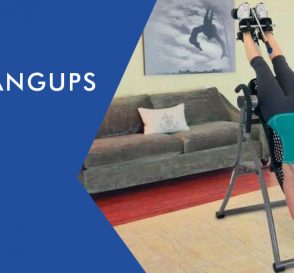It is one thing to be sitting in an office setting day in and day out at a young age, free of bodily ailments. It is another matter entirely if you are expected to do your job while battling acute or chronic pain. For this article, we’re specifically talking about sciatica.
What is Sciatica?
Sciatica is the medical term used to describe pain or irritation caused by the sciatic nerve, the largest nerve in our body that starts at the lower back and lines the leg and foot.
When the sciatic nerve is pinched or compromised, pain can radiate throughout the lower back, hip, and leg.
Symptoms of sciatica

Sciatica can include any number of the following symptoms:
- Pain, tingling, and/or numbness throughout the leg or isolated to portions of the leg (i.e. the thigh)
- Pain in the back, buttocks, hips, or leg
- Increased pain to the back, hips, and legs with prolonged sitting
- Increased pain with bending forward at the hips
Symptoms will not be the exact same for every individual with sciatica.
Pain can be described as radiating, dull, or even inflammatory and can either surface sporadically or remain constant throughout the day.
Chronic sciatica can cause disruptions in an individual’s ability to walk or to do simple day-to-day tasks.
Does sitting cause sciatica?

Sitting down does not necessarily cause sciatica.
However, lengthy amounts of sitting with little to no movement to break your position up can directly flare sciatic pain.
Our spines are made up of boney processes called vertebrae, and in between those bones are visceral, fluid-filled discs.
The spine is the source for the innervation of the entire body.
Disc damage
If the discs are flattened to the point of cellular damage (such as seen in prolonged sitting), then nerves including the sciatic nerve are pinched off.
As a result, pain and/or abnormal sensation can be felt throughout the joints and muscle tissue of the body.
If someone already has spinal damage, such as stenosis, bulging discs, or degenerated tissue/bone, sitting for long periods of time can worsen sciatica.
How to sit properly with sciatica
Most of us don’t have the option to walk out of our office jobs to find other career paths without chairs, we have to make the best of what we have. Believe it or not, there are safe ways to sit in an office chair in order to minimize symptoms of sciatica. Take a look at the following 3 positions:
Flexed position
In other words, this refers to the common “slouched” position that most medical professionals frown upon. In very rare cases of sciatic pain, sitting slouched might actually provide some relief. If you slump over in your chair, pressing your spine into the back of the chair like a C-shape then your hips are forced backwards. Temporarily sitting in this manner might minimize sciatic pain.
Neutral position
Sitting in a neutral, upright position means that you are sitting with your spine completely straight so that your hips don’t fall forwards or backwards. Think of your hips as a bucket full of water and you are trying to keep that bucket upright to prevent spillage. When sitting neutral, you aren’t necessarily pushing any portion of your spine into the back support and your tummy muscles should feel tight.
Extended position
The extended upright position is when you tip your hips (or the bucket) forward by pressing your buttocks into the back support. This creates a space between the support of the chair and you lower (lumbar) back which can be further supported by a pillow or a rolled up towel.
How long does it take for sciatica go away?
This highly depends on whether or not an individual with sciatica has an acute or a chronic situation. Acute sciatica can be very painful, but symptoms are short-lived lasting anywhere for one to several weeks. Chronic sciatica is a lifelong condition in which there is no cure. If sciatica takes a chronic turn, then it becomes about best managing the pain so that you can still live your life.
How to relieve sciatica at the office
Aside from seeking out medical and rehabilitative help, there are a handful of small techniques to add to your bag of tricks that can be easily used in your office space. Examples include using hot/cold packs throughout the day, getting up an going for a short walk regularly, improving your sitting posture, practicing meditation or mindfulness techniques a few minutes per day, and taking short stretch breaks.
Stretching
Stretching should be centralized around your spine and hips, but full-body stretching can be very beneficial in reducing sciatic pain.
Here are just a few stretch techniques that you can implement in your office space:
- Knee to opposite shoulder: Lie on your back and pull one knee at a time up with your hands, pulling towards the same side shoulder and then slowly pulling the knee towards the opposite shoulder.
- Sitting spinal stretch: Sit on the floor with both legs straight in front of you and feet together. Cross one leg over the other, planting the foot in place. Twist your spine by placing the opposite elbow on your knee and placing the other hand behind you.
- Standing hamstring stretch: This is that popular runner’s stretch where you stand and prop one foot up on a bench or other piece of sturdy furniture. Keeping the knee straight, reach for your toe to produce that stretching sensation in the back of your thigh.
- Sitting pigeon pose: Sit with your legs straight out in front of you. Cross one leg over the other and let that leg rest in a half-lotus position. Reach forward for the toe that is still stretched out.
Hot & cold packs
Alternating hot and cold pack use can be extremely helpful in temporarily relieving muscle pain. Hot packs increase blood circulation to muscle tissue while cold packs calm the nerve endings to reduce pain.
Anti-inflammatory drugs
Your doctor may prescribe you with anti-inflammatory or NSAID medication such as Ibuprofen or Aleve. Take only the recommended dose in order to avoid digestive side effects.
Taking regular standing breaks
Avoid sitting throughout your entire work day by purposefully standing up regularly. This might take some active, mental techniques on your part because it is easy to get swept up in office work obligations.
Walking
Going on a walk is one of the easiest ways to relieve sciatic pain because it decompresses the nerve and allows it to do its job. If walking alone does not help, talk to your doctor or a physical therapist about exercises that you could use to strengthen your joints and muscles.
Consider an ergonomic chair
If your office chair is not cutting it, talk to your employer about investing in an ergonomic chair. The best ergonomic chairs on the market allow you to accommodate your sitting position in multiple ways and to your liking. On that note, consult with your doctor about what type of highlights you should look for an ergonomic chair prior to making a purchase.
Consider an orthopedic seat cushion
Besides ergonomic chairs, there are numerous options to choose from when it comes to orthopedically designed seat cushions. Such cushions are made up of soft, contouring material that may provide you with some relief to your lower back buttocks, and hips.
Driving with sciatica
Let’s talk briefly about employees who do not have office jobs, but are still subject to lengthy periods of sitting: drivers. This includes jobs like driving buses, taxis, or commercial trucks all day long. There are some precautions you can take if you are obligated to drive with sciatic pain:
- Keep your head on the head rest as best as possible.
- Maintain a slight space between your lower spine and the back support by propping with a pillow or a rolled towel.
- Keep your hands at 9 o’clock and 3 o’clock on the steering wheel
- Use the foot rest that is installed on the left side in most vehicles. That way, both feet can be kept in approximately the same position for the duration of the drive.
- Position your heel under the gas pedal and not between the gas pedal and brake pedal when resting.
Is massage good for sciatica?
The answer is yes, if done correctly. There are some massage therapists and other specialists who are very familiar with sciatic nerve compression and how to treat it via massage. The key is to find someone who will cause more good than damage. If you have an unlicensed but well-intentioned friend who gives you a sciatic-related massage, then there is a risk for increased pain and immobility. Consult with a specialist who is well-versed in the body’s musculature and innervation patterns.
Working with sciatica is possible if you can take the precautions and proactive steps to manage your pain on a daily basis.The source of sciatic pain will not be the same for everyone, so it is extremely important to talk to your physician before revamping your lifestyle.





